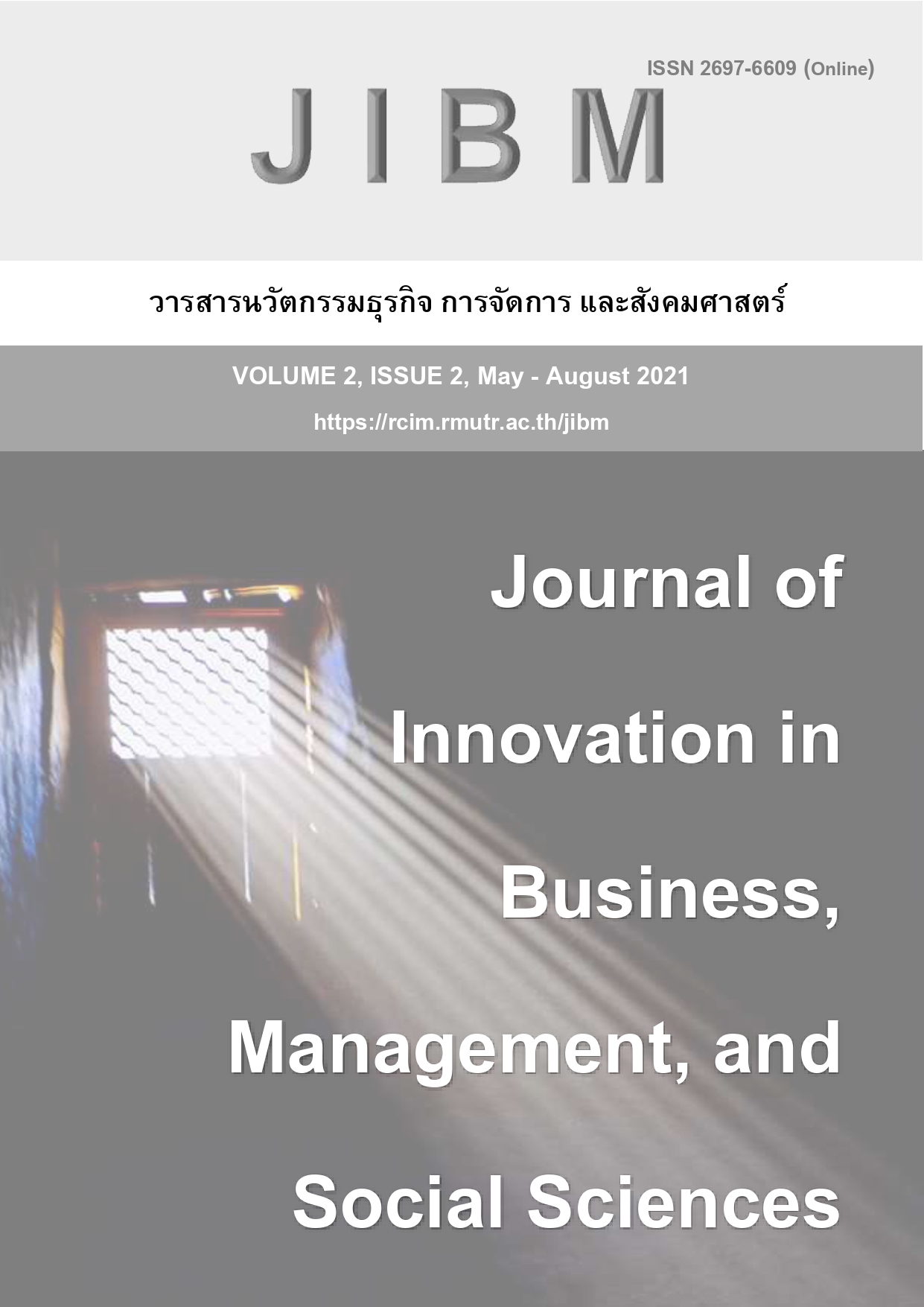FINANCIAL INNOVATION: MODERN METHOD OF PAYMENT IN CHINA
คำสำคัญ:
WeChat Pay, Alipay, Technology Acceptance Model, Theory of Reasoned Behavior, Network Externalityบทคัดย่อ
The current study aims to examine the behavior of Chinese users of WeChat Pay and Alipay. Interestingly, these two-payment platforms play a significant role in China, as it transforms the latter into a cashless society within a few years. The factors which led to such change come from both inside and outside of a person. Accordingly, the researcher conducted an interview survey and subsequently collected 700 samples from 350 respondents who are 100% Chinese. They were given two separate questionnaires, one for the WeChat Pay, and the other for Alipay. Then TAM, TRA, and Network Externality were used to investigate the network on the factors influencing Chinese’s behavior when using the applications. To estimate the result, Factor Analysis, Independent Sample t-test, Panel Data Regression, Linear Regression, and Structure Equation Model were applied. Every method confirmed the robustness of all results. Therefore, the researcher could prove the factors influencing the decision to accept and use e-payment channel and then compare the level of technology acceptance between WeChat Pay and Alipay.
เอกสารอ้างอิง
Abkowitz, A. The cashless society has arrived – only it’s in China. (2018, January 4). The Wall Street Journal. Retrieved from https://www.wsj.com/articles/chinas-mobile-payment-boom-changes-how-people-shop-borrow-even-panhandle-1515000570
Alwahaishi, S. & Snášel V. Modeling the Determinants Affecting Consumers’ Acceptance and Use of Information and Communications Technology [PDF file]. Department of Computer Science, Faculty of Electrical Engineering and Computer Science, Technical University of Ostrava, Ostrava, Czech Republic. DOI: 10.4018/jea.2013040103. Retrieved from https://www.researchgate.net/ publication/57921834_Modeling_the_Determinants_Affecting_Consumers'_Acceptance_and_Use_of_Information_and_Communications_Technology
Burke, R. R. (1997). Do you see what I see? The future of virtual shopping. Journal of the Academy of Marketing Science, 25(4), 352-360. Retrieved from http://doi.org/10.1177/0092070397254007
Cheng, J. (2020, April 20). China rolls out pilot test of digital currency. The Wall Street Journal. Retrieved from https://www.wsj.com/articles/china-rolls-out-pilot-test-of-digital-currency-11587385339
China’s mobile payments market grows over 15% in Q3/2019, Alipay’s market share exceed half. (2020, April 21). China Banking News. Retrieved from http://www.chinabankingnews.com/2020/01/21/chinas-mobile-payments-market-grows-over-15-alipays-market-share-exceed-half
China: A digital payments revolution. (2019, Sep). CGAP. Retrieved July 4, 2020, from https://www.cgap.org/research/publication/china-digital-payments-revolution
China: Number of mobile payment transactions 2019. (2020, April 30). Statista. Retrieved from https://www.statista.com/statistics/244538/number-of-mobile-payment-transactions-in-china
China takes steps to become first cashless society after Covid-19. (2020, April 27). Financial Inclusion for Development [FinDev]. Retrieved from https://www.findevgateway.org/news/china-takes-steps-become-first-cashless-society-after-covid-19
Choi Y. & Sun, L. (2016, February). Reuse intention of third-party online payments: a focus on the sustainable factors of Alipay. MDPI. DOI: 10.3390/su8020147. Retrieved from https://www.researchgate.net/publication/293025965_Reuse_ Intention_of_Third-Party_Online_Payments_A_Focus_on_the_Sustainable_ Factors_of_Alipay/inline/jsViewer/56c7c70308aee3cee5396012?inViewer=1&pdfJsDownload=1&origin=publication_detail&previewAsPdf=false
Digital payments report 2020. (2020, May). Statista. Retrieved May 16, 2020 from https://www.statista.com/study/41122/fintech-report-digital-payments/#:~:text =China%20is%20currently%20the%20biggest,US%241%2C596%20billion%20in%202019.
Gupta, S., & Mela, C. F. (2008). What is a free customer worth? Harvard Business Review, 86, 102 -109
Katz, M. L., & Shapiro C. (1985). Network externalities, competition and compatibility. American Economic Review, 75, 424 – 440
Katz, M. L., & Shapiro C. (1994). System competition and network effects. Journal of Economic Perspective, 8(2), 93 - 115
Klein, A. (2020, April). China’s digital payment revolution. BROOKINGS. Retreived from https://www.brookings.edu/wp-content/uploads/2020/04/FP_20200427_ china_digital_payments_klein.pdf
Lai, P. (2017, Apr 19). The literature review of technology adoption models and theories for the novelty technology. JISTEM - Journal of Information Systems and Technology Management Vol. 14, No. 1, Jan/Apr., 2017 pp. 21-38 ISSN online: 1807-1775 DOI: 10.4301/S1807-17752017000100002. Retrieved from https://www.researchgate.net/publication/317412296_THE_LITERATURE_REVIEW_OF_TECHNOLOGY_ADOPTION_MODELS_AND_THEORIES_FOR_THE_NOVELTY_TECHNOLOGY/link/5939b197aca272bcd1d2bd1e/download
LaMorte, W. W. (2019, September 9). The theory of planned behavior. Boston University School of Public Health. Retrieved May 16, 2020 from http://sphweb.bumc.bu.edu/otlt/MPH-Modules/SB/BehavioralChangeTheories/BehavioralChangeTheories3.html
Li J., Wang J., Wang, S., Zhou, Y. (2019, April 26). Mobile payment with Alipay: an application of extended technology acceptance model. IEEE Access. Digital Object Identifier 10.1109/ACCESS.2019.2902905. Retrieved from https://ieeexplore.ieee.org/stamp/stamp.jsp?tp=&arnumber=8673569
Lin, C. P., & Bhattacherjee, A. (2008). Elucidating individual intention to use interactive information technologies: The role of network externalities. International Journal of Electronic Commerce, 13, 85 – 108.
Lin, K. Y., & Lu, H. P. (2011). Why people use social networking sites: An empirical study integrating network externalities and motivation theory. Computers in Human Behavior, 27, 1152 – 1161. doi: 10.1016/j.cnb.2010.12.009
Lu, L. (2018, January 1). Decoding Alipay: mobile payments, a cashless society and regulatory challenges. Butterworths Journal of International Banking and Financial Law (2018), Vol. 33(1), pp. 40-43. https://papers.ssrn.com/ sol3/papers.cfm?abstract_id=3103751
Ma, Q. & Liu L. (2005, January). The technology acceptance model. IDEA GROUP PUBLISHING, 16(1), 59–72. Retrieved from https://www.researchgate.net/ publication/314410967
Share of Internet users of the leading social networking sites in China as of 3rd quarter of 2019. (2020, June 24). Statista. Retrieved from https://www.statista.com/ statistics /250546/leading-social-network-sites-in-china/
Silverman, B. G. et al., (2006). Artificial Intelligence in Behavioral and Mental Health Care. ScienceDirect. Retrieved from https://www.sciencedirect.com/topics/ medicine -and-dentistry/theory-of-reasoned action
Thomas, H. Measuring progress toward a cashless society. (2013, July). Mastercard. Retrieved from https://newsroom.mastercard.com/wp-content/uploads/2014/ 08/MasterCardAdvisors-CashlessSociety-July-20146.pdf
Wang, C. C., Hsu, Y. & Fang, W. “Acceptance of Technology with Network Externalities”: An Empirical Study of Internet Instant messaging Services, Journal of Information Technology Theory and Application (JITTA), 6:4, 2005, 15–28
Yue, Q. Wenge, R., Hui, C., Yuanxin, O. & Zhang, X. (2018, September). Influencing factors analysis for a social network webbased payment service in China. Journal of Theoretical and Applied Electronic Commerce Research ISSN 0718–1876 Electronic Version VOL 13 / ISSUE 3 / SEPTEMBER 2018 / 99-113. www.jtaer.com DOI: 10.4067/S0718-18762018000300106
Zhang, C., Li, Y., Wu, B., Li, D. (2017, April). How WeChat can retain users: Roles of network externalities, social interaction ties, and perceived values in building continuance intention. ELSEVIER. 69 (2017), 284–293. Retrieved from https://www.researchgate.net/publication/311311561
Zhu, D. H., Lan, L. Y., Change, Y. P. (2017, December). Understanding the intention to continue use of a mobile payment provider: an examination of Alipay wallet in China. Ijbi. Volume 12, Number 4. DOI: 10.6702/ijbi.2017.12.4.2. https://ijbi.org/ijbi/article/download/220/179/



